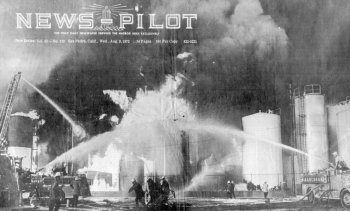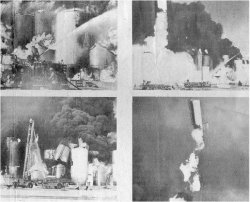| News Pilot, Wednesday, August 9, 1972 
Inferno destroys port tank farm
By XAVIER HERMOSILLO
A spectacular explosion and fire rocked a San Pedro chemical tank farm
late Tuesday afternoon, lighting up the sky for more than three hours causing an estimated
one-half million dollars damage.
More than 100 firemen were treated for minor skin irritations caused by the
firefighting chemicals and two others were rushed to the hospital when they were injured.
Some 250 Los Angeles City Fire Department firefighters were joined by civilians and
other fire agencies as the blaze stayed out of control despite the thousands of gallons of
water streams that were poured into the farm.
At one point early in the battle, a 30,000 gallon tank containing acetone exploded and
was launched skyward some 300 feet before it tipped over on its side and came crashing
down between two groups of firemen on the east wall of the flames.
An undetermined amount of the flammable chemicals, all alcohol-based, were dumped into
the waters of Los Angeles Harbor and city fireboats and Coast Guard vessels used large
booms to stop the flow spread.
Overhead, Los Angeles city and county helicopters joined by Coast Guard helicopters
kept a watch on the spread of both the flames and the chemicals in the water.
Firemen now say that a tank truck accidentally started the fire shortly before 6p.m.
when it hit four or five loading pipes of the General American Transportation Co., 220 E.
Twenty-second St..
Battalion 6 Chief Frank Brown, who headed the firefighting operations until he was
relieved by Acting Chief Engineer Kenneth Long, said the pipes that lead out of the
silo-shaped tanks quickly exploded into flames.
When firemen received the first call, it was reported only as a grass fire at the base
of the 73 tanks in the farm.
However, within one and one-half hours, more than 90 pieces of fire equipment from as
far away as the San Fernando Valley the city of Commerce and East Los Angeles had joined
the operations.
County firemen were called in to help the city crews with large quantities of foam and
the Standard Oil Co. sent several crews and pieces of equipment in to fight the fire.
The 3M Co. also provided firemen with special antichemical agents to help stop the
spread of the flammable liquid that almost over-flowed the base of the farm.
Using aerial ladders and snorkel crews, firemen pouring heavy streams of water into the
tanks found that the problem was worsening.
"The water was mixing with the chemicals and burning right along with it,"
said Dep. Fire Chief Richard P. Carriger. "This is the worst chemical fire I've ever
seen."
More than one hour into the fire, dispatchers Paul Grisgsby, Bill Dunsmore and Bill
Maxwell continued bringing units in from all parts of the city.
However, firemen were not able to gain the upper hand on the blaze until 9p.m. when the
efforts of the Crash 80 trucks from Los Angeles International Airport finally paid off.
The huge, bright yellow trucks that normally battle airplane crashes and crash landings
at the airport, used a light water agent that finally snuffed out the flames.
Firemen explained that the light water, working in the same way as a water softener,
penetrated the chemical base in a way that hard water can't.
For a time, firemen were hampered by the tanks that exploded as the heat in the middle
of the blaze became more intense.
The lids of several tanks became airborne, resembling flying saucers when the tanks
blew their tops. By the time firemen had extinguished the last of the fires, more than 23
tanks had been burned, but firemen were breathing a sigh of relief.
Due to the first positioning of manpower by Battalion 6 Chief Frank Brown, firemen were
able to keep the flames from jumping a line of railroad cars and igniting several
warehouses at Twenty-second and Signal streets.
Firemen manned hose lines atop the Crescent Warehouse and the Scandia Furniture
Company, making sure the highly flammable contents didn't reach the wooden structures.
Fireboats moored nearby at Berth 55 pumped more than 20,000 gallons per minute into the
land companies, taking some of the load off the land water supply.
Department of Water and Power crews kept a close watch on the water pressure, making
sure that a sudden stop on the pressure wouldn't create extensive damage to the city water
system.
Doctors from Harbor General Hospital were flown in by jet helicopter and administered
first aid to firemen who suffered minor burns from the chemicals.
Officials of the company that owns the farm say it may be several days
before an accurate figure can be determined but loss had been set at $500,000.

BLAST OFF--Several firemen escaped death when this tank, containing
more than 30,000 gallons of highly volitile acetates, exploded and was launched 300 feet
into the air late Tuesday afternoon at Twenty-second Signal streets in San Pedro. Fire
razed a chemical tank farm, destroying 23 tanks and causing an estimated $500,000 damage. (News-Pilot
photo by Xavier Hermosillo) |

TOO HOT TO HANDLE--More than 250 Los Angeles City firemen battled
this fire for more than three hours Wednesday at the General American Transportation
Terminal in San Pedro before they were able to bring it under control. In upper right
photo, one of the tanks is launched into the air by the force of the heat while in the
lower right photo, the flaming tank is nearly 300 feet in the air. More than 100 firemen
sustained minor skin burns from chemicals and two San Pedro firemen, Claude Griggs and
Bruce Norman were treated at the hospital. (News-Pilot photo by Xavier Hermosillo)
|
|